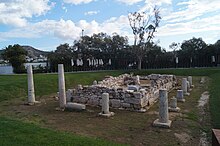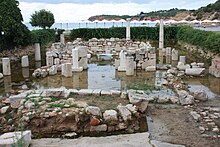Temple of Apollon Zoster
The Temple of Apollon Zoster ( Greek Ναός του Απόλλωνα Ζωστήρα ) is a sanctuary on a peninsula near the modern Athens suburb of Vouliagmeni . The remains of the temple can be found on the isthmus of the Mikro Kavouri peninsula on the grounds of the Astir Beach Vouliagmeni Hotel. The peninsula was called Cape Zoster in ancient times and later Cape Lombarda. It was probably the most important temple of Apollo in Attica and belonged to the demos Halai Aixonides .
exploration
The temple was first mentioned in Pausanias' travelogue . A sanctuary for Athena , Apollo, Artemis and Leto is said to have been located on the peninsula . The name Zoster ( ancient Greek ζωστήρ = waist belt ) is intended to remind us that Leto, on the run from Hera, settled here, pregnant with Artemis and Apollon. It was believed that the birth was imminent, she took off her belt. The archaeologist Konstantinos Kourouniotis suspected that the epithet of Apollon was originally Zosterios and meant that the god was girded with weapons for battle.
In 1924, playing children from the orphanage in Vouliagmeni discovered fragments of architecture and an inscription on the beach that mentioned the temple of Apollon Zoster. In 1926/7 the archaeologists Konstantinos Kourouniotis and M. Pittidis excavated the foundation walls of the temple. Since the temple was built on sand and the sea level had risen since ancient times, the walls were often flooded and damaged. In order to prevent further destruction, the Greek Archaeological Service built a drainage system in 2011, which was financed by the Hotel Astir Beach Vouliagmeni and which drained the walls permanently. In 1936 Phoibos Stavropoulos exposed the priestly house.
description
The temple was built at the end of the 6th century BC. At an already existing cult site. At first it consisted only of the 10.80 m by 6 m large cella with an entrance from the east. Only the north wall, which is made of polygonal masonry , and the paving made of large slabs of titanolite still date from this period. Later one was a cross wall Adyton from the Cella separated. During the second half of the 4th century BC The temple was provided with 4 × 6 columns and thus converted into a peripteros . The surrounding columns were removed again in Roman times and the area in the east of the temple was surrounded by a wall.
In the east of the temple the crepes of the 4.25 m by 2.55 m marble altar were found. An inscription on the altar from the 4th century BC. BC reports that the priest Polystratus had repairs carried out on the temple. Inside the temple, in addition to a marble throne for the priest, three bases were found for the cult statues of Artemis, Apollo and Leto. A sacrificial table measuring 1.10 m by 0.62 m and a height of 0.63 m was exposed in front of the central plinth for Apollon. Presumably there were also such sacrificial tables in front of the two goddesses. In Christian times, the temple was converted into a small monastery dedicated to either Saint George or the Virgin Mary .
About 100 m north of the temple are the foundation walls of the priest's house of 12.40 m by 15.20 m. It served as a guest house for pilgrims and was opened at the end of the 6th century BC. BC or beginning of the 5th century BC Built in BC. The largest room has a square floor plan with a side length of 6.30 m and had 11 clinics . In the 4th century BC Further rooms were added to the BC. The Klinen here, however, were more simply built from small stones and clay. Like the temple, the priest's house was fundamentally redesigned during Roman times. Sinkers for fishing nets were found in the house. From this it was concluded that the priest was fishing as a sideline.
literature
- Ioannis Travlos : Image dictionary on the topography of the ancient Attica. Wasmuth, Tübingen 1988, ISBN 3-8030-1036-5 , pp. 466-479.
- Erwin Freund: Vuliagmeni. In Siegfried Lauffer (Ed.): Greece. Lexicon of historical sites from the beginning to the present. CH Beck, Munich 1989, ISBN 3-406-33302-8 .
- John McK. Camp : The Archeology of Athens. Yale University Press, New Haven (Conn.) / London 2001, ISBN 978-0-300-10151-5 , pp. 316-317.
Web links
Individual evidence
- ^ Pausanias, Travels in Greece 1,31,1.
Coordinates: 37 ° 48 ′ 36.1 ″ N , 23 ° 46 ′ 25.4 ″ E


